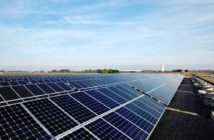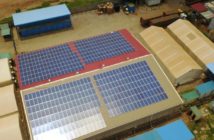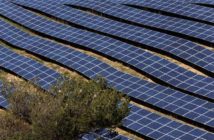By Simon Martelli | AFP
 Morocco said Tuesday it is “very confident” of finding the investment needed to build vast solar power plants in its southern desert regions and become a world-class solar energy producer.
Morocco said Tuesday it is “very confident” of finding the investment needed to build vast solar power plants in its southern desert regions and become a world-class solar energy producer.
“Our target is that in 2020, 42 percent of our power supply will come from renewable energy, including 14 percent from solar,” Deputy Energy Minister Mohammed Zniber told AFP on the sidelines of a conference in Marrakesh.
“At the moment we have only one solar installation, in the east of Morocco, at Ain Beni Mathar, with an installed capacity of 20 megawatts.”
But Zniber said the country expects to build five new solar plants over the next eight years, with a combined production capacity of 2,000 megawatts and at an estimated cost of “less than 9 billion dollars.”
“We are sure that a lot of investors will be interested and that we can find the money for these projects. We are very confident about that,” he added.
Morocco is experiencing a surge in energy demand in 2012, with power consumption to rise by 10 percent, according to Zniber, up from 6.5 percent in recent years.
Unlike its North African neighbours, the kingdom has no hydrocarbon reserves to speak of, forcing it to spend billions of dollars each year on fuel imports and relying on Spain to supply its surplus electricity needs via two interconnectors.
But this has also spurred Morocco into positioning itself as a world-class producer of renewable energy, harnessing the power in particular of the wind and the sun, both abundantly available.
The pilot project at Ain Beni Mathar is a hybrid plant — solar and gas — but the new plants will use only the sun, with the first, located near the desert frontier town of Ouarzazate, to have a 500 megawatt production capacity.
“This is the biggest project of its kind in the world,” said Obaid Amrane, from the Moroccan Agency for Solar Energy (MASEN), explaining that it was being built in two phases and, when completed in 2015, would cover 3,000 hectares.
The Ouarzazate plant should also allow the kingdom to reduce its carbon emissions by 3.7 million tonnes per year.
Other planned solar projects include expanding the plant at Ain Beni Mathar and constructing three new ones in the country’s far south, at Tarfaya, Laayoune and Boujdour.
Separately, Morocco is hoping to add 2,000 megawatts of generation capacity by 2020 from planned wind farms along the coast.
France and Germany, whose Desertec Industry Initiative aims to source future European energy supplies from solar and wind power produced in the deserts of North Africa and the Middle East, are important financial supporters.
So too are the World Bank, the European Investment Bank and the African Development Bank, which said last week that it had approved $800 million in loans in the first half of 2012, to advance Morocco’s wind and solar ambitions.
Grabbing international attention and raising the country’s green profile was the pioneering trip in June by Swiss-made Solar Impulse, a giant sun-powered plane that flew over the Atlas mountains between Rabat to Ouarzazate.
Paolo Frankl, the head of the International Energy Agency’s renewables division believes Morocco is a regional example to be followed, and that its solar energy plans are feasible, even though huge challenges remain.
“The creation of MASEN (in 2010) — an entity which is devoted to this new solar project — is an important step. Because it’s very difficult to introduce a new vision with the old system. You need a new organisation,” he said.






